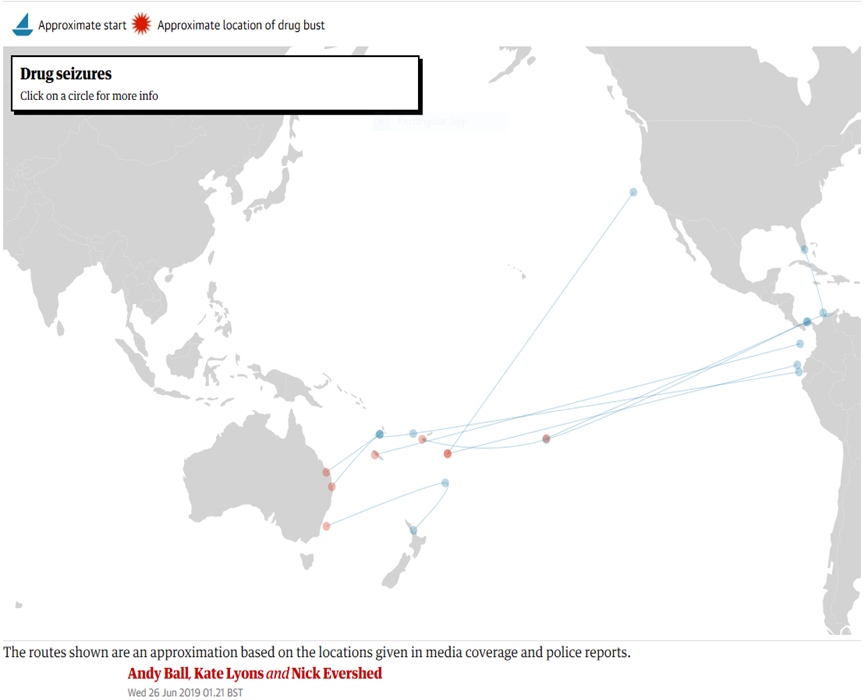- How much organized crime is there?
- Alternative ways to measure organized crime
- Measuring product markets and flows
- Risk assessment
- Key concepts of risk assessment
- Risk assessment of organized criminal groups
- Risk assessment of product markets
- Risk assessment in practice
- Summary
- References
Published in April 2018
Regional Perspectives: Pacific Islands Region - added in November 2019
Regional Perspective: Eastern and Southern Africa - added in April 2020
This module is a resource for lecturers
Exercises and case studies
Regional perspective: Eastern and Southern AfricaCase study 1 (Cocaine trafficking in Tanzania)On the night of 4 March 2011, at Kuhduchi Mtongani area within Kinondoni District in Dar es Salaam region, police officers acting upon intelligence gathered from an informant prepared to arrest suspects who were allegedly trafficking in narcotic drugs. When the police stormed the house, the four men present inside tried to escape. Police officers caught and arrested them. Then, they proceeded to search the premises, finding 81 sachets of a substance eventually tested to be cocaine. The investigation concluded that the four accused jointly trafficked into Tanzania 78,542.47 grams of cocaine, valued at more than 3 billion Tanzanian shillings. The four men, nationals from Nigeria and Pakistan, were charged with trafficking in narcotic drugs, contrary to the provisions of section 16(1)(b)(i) of the Drugs and Prevention of Illicit Traffic in Drugs Act Cap. 95 R.E. 2002. All defendants claimed disassociation with the bags of narcotics: Mr. Okechukwu, the homeowner, claimed the drugs belonged to Mr. Ayaz, his roommate. He also contended he was arrested upon returning to his home in the company of Mr. Hycent and Mr. Obi, whom he had invited to hang out at his place. Mr. Ayaz claimed a third man had shown up with the bags with the instruction to pass them to Mr. Okechukwu, shortly before the police knocked on the door. After a trial in which eight witnesses and 11 pieces of evidence were produced, the High Court of Tanzania sentenced the defendants to 30 years of imprisonment. The convicted appealed the sentence on the grounds that the judgment inverted the burden of proof; the conviction was purely based on circumstantial evidence; and the chain of custody of the narcotic drugs did not follow a proper standard. The Court of Appeal dismissed the appeal. Case-related files
Significant feature
Discussion questions
|
Regional perspective: Pacific Islands RegionCase study 2 (Blue boats apprehended in the Solomon Islands, 2017)The so-called "blue boats" are wooden vessels between 10 to 15 meters long that engage in illegal fishing activities in the Pacific region. These small-scale operations do not carry electronic detectable equipment onboard and are undetectable at sea; in addition to not paying fees or soliciting permits, they utilize fishing techniques that are not legal neither environmentally sound. In recent years, "blue boats" became a concern for the Pacific nations as they have increased both the geographic spread and the frequency of its illegal activities. Regina v. Do Van VA and Others is the first case dealing with Vietnamese "blue boats" in the Solomon Islands. On March 26, 2017, three men were apprehended by the Maritime Police, each in charge of a different "blue boat" fishing in territorial waters of the Solomon Islands. They plead guilty to the offences of illegal entry of foreign fishing vessel, illegal catching and selling of beche-de-mer (also known as sea cucumbers), use and possession of prohibited fishing gear, and engaging in fish processing activities without an export license. The Hight Court of Solomon Islands sentenced them to four years of imprisonment and imposed hefty monetary fines. The vessels, seized during the operation, were forfeited to the Government and ordered to be destroyed unless further usage was required. Case-related files
Significant feature
Discussion questions
Case study 3 (Drug trafficking using a tourist vessel)On June 22, 2018, Fiji Customs officers boarded and searched the yacht "Shenanigans" that arrived at Port Denarau. The vessel had left Florida, USA, on February 2018, and travelled to Colombia, Panama, French Polynesia and Tahiti before arriving in Fiji. The yacht became a vessel of interest for the Border Enforcement Unit upon officers noticing that it did not appear on their Automatic Identification System that uses satellite-based navigation to track vessels. Brisbane, Australia, was the Shenanigans' final destination. John Nikolic, a well-known 45 years old horse trainer from Australia, was the vessel's captain. He was sailing with his wife-under whom the yacht was registered-and a small crew. Fiji Customs officers discovered onboard a shipment of cocaine and methamphetamine that was reported to be valued in more than $20 million, as well as firearms, ammunitions and a large sum of cash. Nikolic drug overdosed while still on the boat at the moment of his arrest and had to be hospitalized. He was found guilty in 2019 of drug importation, possession, and failure to declare arms and ammunitions following a trial at the High Court in Suva. He was sentenced to 23 years of imprisonment with no parole for 18 years. His wife was acquitted of all charges. Case-related files
Significant feature
Discussion questions
Exercise 1 on risk assessmentSelect one of the following environmental cases and conduct a risk assessment drawing from key concepts of this module:
Note pour l’enseignant ou l’enseignante
Conseils aux étudiantsÉchelle de mesure des risques / Niveaux de risque (NR) :
Facteurs pour l’analyse :
Exercise 2 on risk assessmentMake the students play with this interactive map for five to ten minutes. Then, engage them in a discussion about the risks of "spillover effects" of illegally manufactured and trafficked substances into local markets and how this affects communities. Source: The Guardian. |
